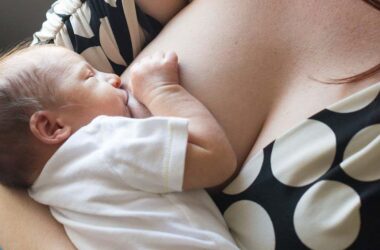Breastfeeding: thrush
One of the problems you may encounter while breastfeeding is thrush. Thrush is a fungal infection, which can affect you, your baby, or both of you. It is annoying, but not a reason to stop breastfeeding.
Thrush is a fungal infection caused by “Candida Albicans. This fungus is present in the body of many people but does not necessarily cause symptoms. In fact, bacteria in our bodies keep the fungus from spreading to the point where it can bother you. In some situations, however, those bacteria are no match for the fungus and a fungal infection occurs. In many women, the Candida fungus is present in the vagina. Since the baby goes through this at birth, he too can become infected.
Causes of thrush
In the mother, the fungus can emerge and cause thrush due to stress, decreased resistance, nipple fissures, use of antibiotics, and insufficient airing of the nipples when using a bra or nursing pads. The baby is susceptible to the fungus because his immune system is not optimal.
Discover and stimulate your baby's mental development
Download nowSymptoms
There are several symptoms of having thrush. You may feel a stabbing pain in your breast during or after a feeding. Your nipples may be itchy and scaly or look red and shiny. Always check first for other possible causes. Incorrect latching on or off, or having very full breasts can also cause pain. Whether the baby is suffering from thrush can also be judged by several symptoms. The most noticeable symptom of thrush in your baby is that he has white spots in his mouth that you cannot wipe away.
So look closely at his lips and the inside of his cheeks. In addition, restless drinking at the breast can be a symptom. The baby’s mouth hurts because of thrush. As a result, he will latch off more often during drinking, which you can hear as a kind of clicking sound. Diaper rash can also indicate thrush. It often develops several days
Treatment of thrush
It is important to treat thrush. If you have symptoms contact your doctor. You can also ask your midwife, maternity nurse, or lactation consultant for advice first. It is a bummer if breastfeeding fails due to late detection or late treatment of thrush. Treatment consists of a combination of antibiotics and taking extra hygiene measures. If you do not get yourself and your baby treated, there is a chance of infecting each other continuously and back and forth during feedings. As long as you do both receive treatment, you can continue breastfeeding as usual.
If it is too painful to feed right from the boob, you can also pump milk temporarily and give it to your baby. Do not store pumped milk when you have thrush, as the mold will remain in the milk. In fact, the mold does not disappear when the milk is frozen. If you then give that milk to your baby a week after healing, for example, you may infect him again.
Thrush is absolutely no reason to stop breastfeeding!
Want to know everything about your baby’s mental development and find out how you can stimulate this? Download The Wonder Weeks app or buy the book.
Did this article help you?
Share this article
Receive a notification at the start of a leap!
Would you like to be prepared when your baby is about to enter a leap? Sign up for our leap alarm for free and always receive a notification when a leap is about to start!


